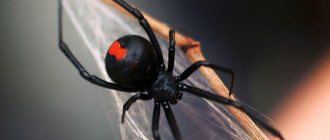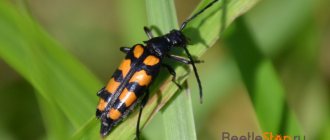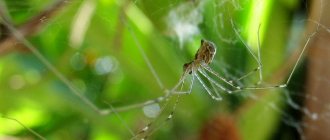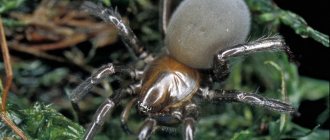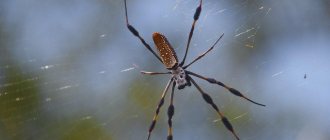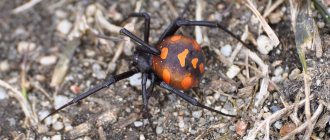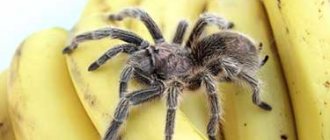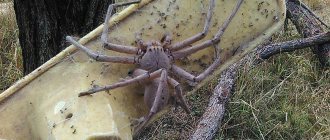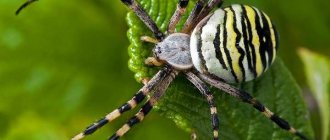The wasp spider is named so not only because of its black and yellow stripes. His waist is just as small and he can fly! Not on the wings, of course, on the threads of the web, which are picked up by the wind.
A little information:
The official name of the wasp spider is Argiope Bruennichi:
- Argiope is a nymph from ancient Greek myths (250 years ago it was fashionable to name insects after mythological heroes);
- Brünnich is the name of a Danish zoologist who published a major book on insectology in the late 1700s (full name: Morten Trane Brünnich).
Keeping Argiope Brunnich at home
Argiope takes root well in a terrarium.
Even in an ordinary aquarium, if instead of a lid you put a fine mesh so that it doesn’t crawl out and at the same time breathes freely. You can throw dry grape branches or other dry vegetation inside. The wasp spider only lives for a year, but if you give it a mate in time, then you will have a cocoon in your aquarium, and hundreds of spiders will fight for survival in the spring. At home, you can just watch how a black spider with yellow stripes sets up a secret lair, how it pulls signal threads and stores up food. You can feed him once every 2 days - with any insects (preferably from a pet store). If he doesn’t eat it, at least it will be interesting to fight. And you can scare children - they don’t know whether it’s poisonous or not (it’s not poisonous, so that’s all the more fun).
Source
Folk signs
Spiders, for the most part, are harmless animals, and people have many superstitions about them:
- if a spider came into the house, good luck came with it;
- spiders living in the corners attract all the negative energy, preventing it from spreading to the owners of the house;
- if it weaves a thick web, it means drought;
- sits in the corner of a large web - predicts rain;
- a spider seen in the bathroom warns against danger: something you planned will not bring benefit, but harm;
- the presence of a spider in the house means prosperity;
- a spider crawling towards you promises sudden profit. Creeping away from you - to expenses;
- if an arthropod scares you, this means unpleasant news. But if you are not afraid - good news;
- If you notice a spider hanging from the ceiling by a thread, pay attention to where it is moving. Up - to the fulfillment of a desire, down - the dream is not destined to come true;
- did a spider fall on your head? Expect to get rich soon;
- The earlier in the day the little fly hunter was encountered, the more negative the overall effect of the omen. Ideally, meet him in your apartment late in the evening;
- You cannot kill spiders - you will lose your health and luck.
Invader Queens
This insect is unique among all other hornets in that it parasitizes the nests of its fellows:
- At the end of the summer season, the female black hornet looks for a hive of some small species of hornet, fights her way into it and destroys the queen. As a rule, only a few succeed, since soldiers and workers fiercely and completely protect their womb and will never recognize a new womb while the old one is alive. Of course, the individual that was able to capture the nest contributes to the emergence of new black hornets, which more than compensate for the death of the males and females of this species.
- Using special pheromones, the female black hornet, like a chameleon, disguises itself as representatives of another species. The workers determine by smell that this is their queen, whom they serve, and, as if nothing had happened, they continue their work of providing the nest with food and building material.
- After this, the female begins to lay eggs, from which larvae soon hatch. Working individuals, suspecting nothing, feed them until they become adults and ready to reproduce.
- Then swarming and mating occur. The males die, and the fertilized females fly away in search of new nests on which they can parasitize, or, if the cold season is ahead, they look for shelter for the winter.
Very rarely, black hornets build a hive and live together. This behavior is explained by the fact that in the area where they live, there is no one for them to parasitize, so the search for other people’s nests can end in failure and lead to their extinction.
Why is a bite dangerous?
Due to the fact that this insect is a parasite, its poison is stronger than that of its relatives, which are widespread in Russia. This is due to the fact that the female black hornet must kill her rival when capturing someone else’s hive.
Since her opponent belongs to the same family as she does, she is, accordingly, immune to the usual poison of representatives of related species. Therefore, to eliminate the enemy, nature awarded black hornets with additional toxins, allowing them to achieve their goals.
After being bitten by this insect, a person experiences the following symptoms:
- sharp throbbing pain;
- inflammation of the affected tissue at the site of the bite, accompanied by itching;
- dyspnea;
- cardiopalmus;
- headache;
- swelling of the mucous membranes;
- allergic reaction to a bite;
- Quincke's edema is possible;
- very rarely, in 5-6 percent of recorded cases, the consequence of a bite is anaphylactic shock, which ends in death without medical attention.
First aid for a bite:
- An ice compress on the affected area is required.
- To prevent an allergic reaction, take an antihistamine, such as prednisolone or suprastin.
Go to the hospital immediately if you have a high temperature, swelling of the mucous membranes, dizziness or headache, remember that in about 5 cases out of a hundred, a bite can result in death without medical intervention.
Reproduction of Argiope
The mating period occurs immediately after the female moults, which precedes puberty. At this time, the covers of its chelicerae are still soft. Everyone knows the sad fate of the male karakurt spider (black widow). It is simply eaten by the female immediately after mating, thereby increasing the chances of survival of her offspring. In the case of agriope, we observe a similar situation.
In July, at the edges of the web, as a rule, you can see a male waiting for the last moult of the female. As mentioned above, one pair of its limbs is transformed into bulbs. During the fertilization process, one of them falls off. If the male manages to hide from the female, then he can mate with another female.
Argiope Brünnich lays its eggs in a large cocoon (pictured above), which resembles the structure of a plant capsule. It is located near the web. The spider is fertile, the number of eggs laid at one time reaches several hundred. At the beginning of autumn, young spiders are born. They leave their cocoon in a rather peculiar way. Young individuals climb to heights, then release a long thread and, with a gust of wind, are carried away with it. Thus, the species spreads across natural biotopes. The full life cycle of this type of spider is one year.
In the next photo you can see spiders just emerging from the cocoon.
Habitat
The species of Argiope Brünnich (photo according to the text) is widespread in Central and Southern Europe, North Africa, Kazakhstan, Asia Minor and Central Asia, India, Japan, Korea and China, and the Caucasus. The northern limit of habitat in Russia, according to data from the early 70s of the last century, reached 52-53º N. w. Since 2003, information began to arrive that Argiope was discovered much further north of the indicated line.
In Russia, this type of spider can be found in the Oryol, Bryansk, Lipetsk, Belgorod, Penza, Voronezh, Ulyanovsk, Tambov, Saratov, Ryazan, Tula, Moscow and Chelyabinsk regions. In 2015, argiope was discovered in the Rdeisky Nature Reserve (Novgorod region). Active dispersal is facilitated by the unusual method of movement of young individuals - with the wind.
Argiope Brünnich's attraction to xerophilic vegetation is observed. Spiders prefer dry air and cannot tolerate high humidity. They settle, as a rule, on herbaceous plants and shrubs located in meadows, roadsides, forest edges and other open sunny areas.
Description and features
To describe the appearance of Argiope, we need a number of special “spider” terms.
1. First, let's introduce you to the concept of chelicerae. If translated from ancient Greek, you get two words - claw and horn. This is the first pair of limbs, or jaws, of arachnids and other arthropods. They are located in front of and above the mouth.
They usually look like claws and consist of several segments. At the tip of such claws there are ducts of poisonous glands. Now we can explain who araneomorphic spiders are - their chelicerae are located towards each other, and they fold together, sometimes overlapping one another. Such chelicerae are designed to attack large prey, sometimes larger than the hunter himself.
2. The second important term in the description of spiders is pedipalps. Translated from ancient Greek, we get two words again - leg and feel. This is the second pair of limbs, the pedicles, located on the cephalothorax (called the prosoma in chelicerates). They are located on the side of the chelicerae, and behind them there is a second pair of walking legs.
“Dismembered” into several segments, like phalanges. Adult male spiders use every last segment of the pedipalp at the moment of copulation with the female. They are transformed into a kind of sexual organ called the cymbium. It is used as a reservoir for sperm, as well as for directly introducing it into the female's genital openings.
3. And the last complex concept is stabilimentum (or stabiliment). This is a prominent thickening on the web. Usually made in the form of a zigzag weave of numerous threads at the center. There can be one, two, three or more such pronounced thickenings, depending on the type of spider.
It can be vertical in the form of a line, it can go in a circle, or it can be in the shape of a cross. Moreover, this cross is made in the form of the letter X. A very important thing for spiders, as you can see, since they constantly make it on their web. Its exact purpose has not yet been studied by people, despite numerous attempts.
Argiope weaves very strong webs that can trap medium-sized grasshoppers
Perhaps it attracts the attention of the victim, or, conversely, scares away enemies, or disguises a spider in its background. There are so many versions! The version about attracting victims is closest to the truth, especially since the purpose of the web itself is a trap
By the way, it is the stabilimentum that is best visible in ultraviolet rays, which many insects “see”.
Some spiders initially had a linear shape of the stabilimentum, but over time it became cruciform, which also speaks in favor of the version of luring prey. As they say, they do any “tuning” to achieve the desired goal.
Externally, spiders look like this:
The abdomen is entirely covered with transverse stripes of lemon and black color, with light gray stripes between them. Closer to the cephalothorax, the color completely becomes pearl gray or brown. The prosoma itself is entirely covered with a velvety-silver undercoat.
The head is black and there are four pairs of eyes on it, different in size: 2 pairs of small eyes at the bottom, 1 medium pair of large eyes looking straight ahead and 1 pair of eyes, medium in size, on the sides of the head. It also has eight paws, arranged in pairs, the first and second being the longest. The third is the shortest, and the fourth is average.
Due to its bright coloring, Argiope is called the wasp spider or tiger spider.
The size of Argiope is not the largest among spiders, but nevertheless noticeable. The females are large, body length up to 3 cm. And with the length of the legs they reach 5-6 cm. The chelicerae are small. The shape of the body is closer to an oval, the length is twice the width. There are spider warts on the abdomen. These are the organs that form the arachnoid web. This was a female Argiope that was described.
“Men” are several times smaller than “ladies”; they grow up to 0.5 cm. They look inconspicuous and, in the literal sense, gray - they are most often mouse-colored or black, without any stripes. The cephalothorax is usually without hairs, the chelicerae are even smaller than in females.
The family of orb-weaving spiders (Araneidae), which includes Argiopes, is characterized by the production of a large circular network - a catcher's web. The main radial threads are thicker; a thread running in a spiral is attached to them.
The space between us is filled with rosettes in a zigzag pattern. Argiope's web is vertical or at a slight angle to the vertical axis. This arrangement is not accidental; spiders are excellent catchers, and they know how difficult it is to get out of a vertical trap.
Steps
Recognizing Poisonous Spiders
Determine if it's crawling on your arm.
When it comes to spider identification, the first thing to rule out is the brown recluse spider. It is the most dangerous spider in the United States and is most common in the Southeast and Midwest. A brown recluse bite can cause an infection, which may require medical attention. Here's how to tell if the spider you find is a brown recluse:
Do your research to find out the type of spider.
Memorize or write down the spider's appearance, and if you have time, look at the World Spider Catalog, the Online Journal of Arachnology, and other expert-compiled online sources to find the spider you're looking for and compare it with pictures of other species.
WikiHow also has useful articles about spiders. More information can be found in the articles “How to identify a garden spider”, “How to identify a barn spider”, “How to identify a redback spider”, “How to recognize a tarantula spider”.
Taking into account other basic factors
Make sure it's really a spider. Many people think that spiders are insects, but in fact this is not true at all. To make sure that the creature you meet is really a spider, you should pay attention to the following:
Two body segments. Unlike insects, which have three body segments, spiders have only two. Eight legs Do not confuse antennae and legs. Lack of wings. No spider has wings
No matter how much a creature resembles a spider, if it has wings, it is not a spider.
Spider (lat. Araneae) belongs to the phylum arthropod, class Arachnida, order Spiders. Their first representatives appeared on the planet approximately 400 million years ago.
Is the wasp spider poisonous or not?
The arthropod has poisonous glands that produce a toxic substance. When it enters the victim's body, it causes muscle spasm and immobilization. The poisonous brunette is not distinguished by its aggressive disposition and does not attack unnecessarily. For humans, its presence nearby does not pose a danger. However, if the argiope feels a threat to his own life, the attack will follow.
Due to its unusual color, wasp spiders are kept at home as pets. They live in specially equipped aquariums and feed on insects. Feeding should be done every other day. up to 1.5 years.
The karakurt spider is one of the most dangerous creatures on earth. Despite its small size and non-threatening appearance, the karakurt's venom is 15 times stronger than that of a rattlesnake and 50 times stronger than that of a tarantula. For a horse or camel, a karakurt bite is often fatal.
The karakurt spider is one of the most dangerous creatures on earth
Without prompt medical intervention and professional help, a meeting with a person can also result in death, although such cases are extremely rare. The black spider evokes mystical associations due to the presence of 13 bright red spots on the body and cannibal family traditions. Kalmyk shamans use a dangerous creature in some rituals. There is a common belief that karakurts live only in deserts and do not pose a danger to residents of the central and even southern steppe and forest regions, but this is not true. Recently, the migration of biting “robbers” to the north has been obvious, and climate warming has led to the fact that karakurts are recorded in regions where they have never been observed before.
The poisonous karakurt spider belongs to the order of spiders of the family of web spiders from the genus of black widows. Translated from the Turkic language, the name is literally translated as a black worm. The Latin name Latrodectus tredecimguttatus reflects the external characteristics - 13 points on the back and the essence of the spider (biting robber). Like the karakurt, which is sometimes called the steppe spider? In terms of size, the spider belongs to the medium arachnids. The size of the male is 4-7 mm, the female karakurt is 2-3 times larger and can reach 20 mm. The body of the eight-legged spider is black, with a pronounced abdomen. Both males and females have red spots or dots on the upper side of the abdomen. On the lower part of the abdomen a clear scarlet pattern is visible, similar to the outline of an hourglass. The spot on the abdomen often has a snow-white halo. Adults (males) can be completely black. Karakurt is a predator; it feeds on insects, which it uses a web to catch.
Despite its small size and non-threatening appearance, the karakurt's venom is 15 times stronger than that of a rattlesnake and 50 times stronger than that of a tarantula.
White karakurt, also related to web spiders, has a white or yellowish color. There is no hourglass pattern or spots on the body, but there are 4 indentations forming a rectangle. White spiders are much less poisonous, their bite is not dangerous to people, although the venom of the white karakurt is similar in its toxicological properties and effects on the human body and animals to the venom of the black widow. White karakurts can be found in Russia and neighboring countries, but the main habitat is located further south - in North Africa, the Middle East, and also in Central Asia
Let's focus on the black widow karakurt as the most dangerous representative of the internet, which you can meet at domestic resorts
Karakurts are distinguished by their fertility; in the southern regions there are periodic surges in the birth rate, which entail an increase in the number of casualties among people and loss of livestock. Poisonous spiders in Kazakhstan and Crimea attack dozens of people every year, but serious consequences occur extremely rarely. The female lays more than 1,000 eggs per year, which are placed in a protective cocoon. The newly born spiders continue to live inside the cocoon and emerge from there only next spring. Puberty occurs 2-3 months after the spiderlings leave their original home. Eggs are laid in holes on the ground or in rodent burrows. Fertilization occurs during the hottest months of summer. After mating, the female karakurt eats the male, although there are exceptions - for unknown reasons, the female can either destroy the male before mating or leave him alive after fertilization.
Is a bite dangerous to human health?
Argiope brunnich is not capable of causing serious harm to a person, much less killing. In general, this spider is not aggressive, and therefore will not just attack a person. It’s another matter if you disturb it, for example, by picking it up.
In such a situation, the animal will perceive you as a threat and will try to defend itself. As a result of a bite, a slight swelling in the form of mild edema may form on the body, and mild pain, itching, and tingling may also be observed.
Important! The bite site should be cauterized as quickly as possible using a match. As a result of a thermal attack, the poison is destroyed and loses its properties. Also, the bite site should be treated with an antibacterial substance and, if possible, take an antiallergic drug.
Lifestyle
Representatives of this species prefer to live in small groups of 20 individuals each. They live in fields and meadows, in forest areas, as well as in other places with dense vegetation. At the same time, they choose open areas that are well translucent and warmed by the sun's rays.
To build a web, these insects choose a large spreading plant or build it between several bushes. It takes a spider about an hour to make one trapping net, and the construction process itself always occurs at dusk. The central part of the web consists of a stabilimentum - a pair of clearly visible threads located opposite each other, which diverge from the middle.
This is interesting! The web of argiope bruennichi has the ability to reflect ultraviolet rays and this is quite good at attracting insects!
The finished fishing net is very beautiful - it has small cells arranged in a zigzag pattern. And at its center there is always a wasp-like spider. The mistress sits on the underside of the web, spreading her long legs wide apart, and patiently waits for the next victim to fall into the trap.
The basis of the wasp spider's diet consists of insects, both orthoptera and others. Most often, the following networks fall into the placed networks:
The victim caught in the web begins to twitch, which attracts a hunter located nearby. The spider immediately approaches, plunges its jaws into the body of the prey and paralyzes the caught insect with poison. As soon as the prey freezes, the hunter deftly wraps it in a web, bites off the restraining threads and hides it in a secluded place.
After some time, the poison, which contains digestive enzymes, softens the victim’s body, after which the spider begins to eat.
The female becomes sexually mature immediately after molting. She sheds her old chitinous cover and allows the male to fertilize her, after which she eats him.
On a note! Scientists still cannot come to a consensus as to why she does this. Some believe that in this way she is trying to saturate her body with protein, which is necessary for normal gestation of eggs. Others believe that a natural reflex is triggered - the female eats the male due to incompatibility in size, that is, it acts on the principle of natural selection, when large individuals destroy small ones!
A female spider with a color like a wasp lays eggs about a month after mating. She weaves several cocoons from the web and places approximately 400 eggs in each. She hangs all the cocoons near her fishing net and soon dies.
Future offspring spend the entire winter in a dense, warm cocoon. With the arrival of warmth, the young emerge from the eggs and spend some time in close proximity to the cocoon. During this period, many spiderlings die and there is only one reason for this - overpopulation of the territory, due to which there is not enough food for everyone. Thus, some packs die due to hunger, others are eaten by their own brothers.
The survivors leave their homes around August. In windy weather, they scatter around the surrounding area using their web. In the fall, the young reach sexual maturity.
Nutrition
The tiger spider weaves large trapping nets that have a complex beautiful pattern and small cells. The spider waits for its prey in their very center.
In this case, the first two pairs of legs are directed forward, and the third and fourth pairs are directed back. Thus, visually, the spider’s body takes the shape of the letter X. The spider does not have very good eyesight, but it perfectly feels the vibrations of the air and the web.
Argiopes mainly feed:
- grasshoppers;
- crickets;
- locusts;
- mosquitoes;
- flies.
But often other insects get caught in the net, which the spider is not averse to snacking on. As soon as the prey falls into the trap, the spider senses the vibration and rushes towards the victim.
The spider attacks the insect, bites and injects poison under the chitinous layer. For some time the predator watches the prey from a distance. As soon as the insect stops moving, the argiope wraps the victim in a web.
The spider bites through the threads holding the prey. He lowers the victim to the ground to feast on it in a secluded place or hide it in reserve. One Argiope prey can last for a week.
Argiopes, like other spiders, have external digestion. The arthropod's venom promotes the decomposition of the insect's entrails. Some time after the bite, the spider returns to its prey. It sucks out all the insides of the insect, leaving only the chitinous layer.
Sometimes the argiope itself becomes a victim if a wasp or too large beetle gets caught in its net. The spider tries to escape, but sometimes it can be caught by its own victim or pierced by the poisonous sting of a wasp.
General information
The yellow-black Argiope spider was named after the famous Danish zoologist Morten Brunnich. The cephalothorax and abdomen of the animal are connected by a thin septum and are very mobile. The body length of the wasp spider reaches 2.5 cm if we are talking about females. Males do not exceed 1 cm in length.
A distinctive feature of this species is the clear difference between representatives of different sexes. Females are always significantly larger than males, their abdomen is round and oblong. In males, the body is a solid elongated oval without clear distinctions between the head and abdomen.
The arthropod received its unofficial name and comparison with known insects thanks to the transverse stripes on its back. The color of the stripes is black, and they are located on a bright yellow background, which ensures the similarity. The animal's legs are light in color and have black tips. The female always looks brighter than the male.
In this video you will learn about the wasp spider:
Habitats
The Argiope spider is a fairly common species. It can be found in many countries of North and South Africa, America, Korea and China. Argiope Brünnich is found in Indonesia and Central Asia. Southern and Central Europe, Crimea, and Kazakhstan are also rich in this type of arachnid.
You can meet a spider in the CIS countries only in the southern regions
The arthropod is widespread throughout Russia and the eastern part of Ukraine. It prefers a mild climate and does not tolerate cold well, so it is extremely rare in that part of our country where a damp and cold climate prevails.
The wasp spider prefers to be in the sun most of the time. That is why its favorite habitats are open meadows, lawns and places along highways. The animal prefers to place its web on low plants growing in particularly dry areas.
An interesting feature of the striped animal is that, thanks to its long and strong web, it can move quite long distances and easily adapts to new conditions. Quite often, southern varieties can be found in areas with colder climates.
Lifestyle Features
The black-and-yellow arthropod does not like loneliness, so it settles with its close relatives in groups of 15-20 individuals. This helps them hunt prey together and raise offspring. After the main female in the flock chooses a place to settle, weaving a web to catch insects begins.
The essence of the wasp spider's hunt is to wait for prey to fall onto the web.
Each member of the flock weaves an extensive web, distinguished by its strength and beautiful pattern, in about 60 minutes. Its peculiarity is that even the smallest hole will not let in prey that has already been caught in the net.
The web is also distinguished by its variety of patterns and multi-layered nature. According to research, individuals weave it in several layers so that it reflects ultraviolet rays. The shine attracts insects of different species, providing the colony with a constant supply of food. Weaving usually begins at sunset.
Wasp spider feeding
The striped spider prefers to feed on grasshoppers, various types of locusts, and its diet also includes mosquitoes, flies and other common insects. They get caught in the web, after which the animal begins a ritual of eating, which is almost indistinguishable from the feeding habits of other spiders:
- When caught in a net, an insect tries to free itself.
- To prevent the prey from tearing the net, the argiope bites it. When bitten, the venom and digestive enzymes of the arthropod enter the insect.
- The poison immobilizes the victim, and he stops trying to free himself.
- Next, Argiope Brünnich waits for some time until the enzymes make the food suitable for consumption. They actually dissolve the insides of the insect, and after a certain period of time, the wasp spider simply drinks the liquid, leaving a chitinous shell.
It is worth noting that the unique and multi-layered pattern of the web allows the arthropod not to be left without food, since it attracts a large number of different insects during the day. As a rule, after several insects become entangled in a web, the animal leaves this place and weaves a new one. This avoids scaring potential victims away from beautiful networks.
Arachnids
The arid regions of Central Asia and Africa are home to large arthropods that are often mistaken for spiders. These are salpugs. According to the tracing paper from English, they are also called. But unlike spiders, salpugs have teeth, they do not have arachnoid glands and are not poisonous.
Salpuga is a large animal capable of catching up and killing not only invertebrates, but also small lizards. The chelicerae of large salpugs are so powerful that they can bite through a human fingernail. No real spider is capable of this. Although salpugs do not have poison, their bite can be very dangerous. Particles of decaying flesh remain on the chelicerae of these arthropods. After a bite you can get blood poisoning.
Spiders cause many problems, although they are one of the most harmless and useful inhabitants of the planet. Spider lovers consider them “kittens.”
The wealth of species in the wild is simply staggering. There are over 35 thousand species of arachnids alone.
And in this article we will look at one of the amazing subspecies, allegedly similar to a wasp - Argiope bruennichi.
Read on to learn about the features of appearance, habitat, lifestyle, methods of weaving webs, reproduction, danger to humans and the possibility of keeping them at home.
Danger
The venom of the wasp spider is deadly to insects, but practically harmless to humans. At the same time, argiope bruennichi does not purposefully attack people. This insect can only bite accidentally if it is disturbed by picking it up. The affected area may experience:
- slight swelling;
- redness;
- burning;
- pain.
But these symptoms often go away very quickly. If after a wasp spider bite you begin to experience discomfort, then apply something cold to the affected area to speed up healing. After such a compress, the pain subsides and the swelling goes away.
In general, the venom of the wasp spider is quite weak for humans. However, sometimes, in particular with weak immunity, the body’s negative reaction can be quite intense. In such cases, anti-inflammatory ointments usually help. The poison of argiope bruennichi can be dangerous for humans only if there is an allergy to insect bites. In this situation, you should definitely seek qualified medical help.
Argiope Brünnich spider
belongs to the araneomorphic species. This is a rather large insect, males are smaller than females. The body of an adult female can reach from 3 to 6 centimeters, although there are larger exceptions.
Argiope males
, on the contrary, are small in size - no more than 5 millimeters; in addition, the boy’s narrow little body is usually painted in a nondescript, monochromatic gray or black color with a light belly and two dark stripes on it located along the sides. On light legs there are faint, vague rings of a dark shade. The pedipalps crown the male genital organs, otherwise called bulbs.
The photo shows a male Argiope spider
The female differs not only in size, but also in general appearance. Female Argiope black and yellow
striped, with a black head, there are small light hairs on the rounded-oblong body. If you count starting from the cephalothorax, then the 4th stripe differs from the others by two small tubercles in the middle.
Some scientists describe the legs of females as long, thin, black with beige or light yellow rings, others believe the opposite: the legs of the spider are light, and the ringing stripes are black. The span of the limbs can reach 10 centimeters. In total, the spider has 6 pairs of limbs: 4 pairs are considered legs and 2 are considered jaws.
The photo shows a female Argiope spider
The pedipalps are quite short, more like tentacles. It is because of the combination of black and yellow colors, expressed in stripes on both the body and legs, that Argiope is called the “wasp spider.”
. The beautiful color of the spider also helps it not to become dinner for, because in the animal world bright colors indicate the presence of strong poison.
Another fairly common variety is Argiope lobata,
or otherwise -
argiope lobata
.
The spider received its first name because of the unusual shape of its body - its flat belly is crowned with sharp teeth along the edges. Argiope lobata in the photo
resembles a small squash with long thin legs.
The photo shows the spider Argiope lobata (lobed agriope)
Representatives of the species are widespread throughout the world. They are found in Europe, Asia Minor and Central Asia, in most regions of the Russian Federation, Japan,. The preferred place of life is meadows, forest edges, and any other well-lit places.
The question often asked is “ is the Argiope spider poisonous or not?
“, the answer to which is definitely yes.
Like most spiders, argiope is poisonous
, but it poses absolutely no danger to humans - its poison is too weak.
The insect does not express aggressiveness towards people;
only a female
Argiope
bite and only if you pick her up.
However, despite the weakness of the venom, the bite itself can cause pain, as the stings penetrate deep into the skin. The bite site almost immediately turns red, swells slightly, and becomes numb.
The pain subsides only after a couple of hours, but the swelling from the bite of the Argiope spider
may last for several days. Only people with allergies to this kind of bites should be seriously afraid. Argiope thrives in captivity, which is why (and because of its spectacular color) representatives of the species can often be seen in terrariums.
Read with this
Southern regions of the country
The warmest regions are home to the following spiders:
South Russian tarantula
The popular name is Mizgir. Habitat - central and European Russia, namely steppes and semi-deserts. The female tarantula grows to a huge size of 3.2 cm, males are 5 mm smaller, weight starts from 30 grams, the maximum weight of an adult reaches 90 grams. Such parameters cannot but impress! There is no doubt about which spider is the largest in Russia - it is definitely a tarantula.
The massive body is dark brown or dark gray and covered with many hairs. Due to the large number of hairs, the spider looks very fluffy. Tarantulas live alone, except for the mating period. The diet, in addition to standard midges and flies, is supplemented by frogs and mice. Representatives of this species are true hunters; they prefer to guard, attack and chase large prey, while inflicting additional bites. Despite the terrifying appearance and predatory nature of the spider, it can bite a person if it senses danger. The bite is dangerous only due to an allergic reaction - redness and irritation.
Argiop
The popular name is wasp spider or wasp spider. It received its nickname due to the similarity of the color of the females of this species with the wasp: a yellow abdomen with black and white stripes. Distributed in the Krasnodar region, Astrakhan region and Volga region - warm regions. Argiopes have pronounced gender differences: females are large and bright, up to 3 cm, and males are on average 0.5 cm and have a dark gray or brown color.
An interesting feature of spiders is their “gregarious” life - the number of individuals in a group is up to 20. The wasp spider is poisonous, but its poison will not cause serious harm to health. In terms of pain, the sting can be compared to that of an aspen or a bee; it will be painful and swollen. An allergic reaction is possible. Argiope will never attack first, but if you accidentally touch its web, an immediate reaction will follow.
Appearance
The body is divided into the abdomen and cephalothorax, which are connected to each other by a thin stalk. The cephalothorax is covered with a durable chitinous layer that protects it from mechanical damage.
Inside it is the brain and stomach. 4 pairs of walking legs, a pair of pedipalps and a pair of chelicerae extend from it. The limbs are thin and long. They help the spider deftly move along the shaky threads of the web. The pedipalps are used for touching and grasping prey.
The spider has 8 eyes, which are located on the front of the cephalothorax. One pair is especially large, located on top. Others are smaller, located in front and to the side of the largest pair.
There are also chelicerae that end in sharp curved fangs. Venom glands approach the fangs. On the last pair of legs there are special appendages, which consist of a layer of bristles.
They are used for weaving multilayer networks with complex patterns. With their help, the spider arranges its webs into the patterns it needs. This is a characteristic feature of all orb weavers. At the back of the lower part of the abdomen there are arachnoid appendages.
The tiger spider is famous for its strong sexual dimorphism. The body of females reaches 1.5 cm in length, males rarely grow more than 5 mm. The female's paw span can reach 4 cm.
Females boast a brighter color, which is designed to indicate the poisonousness of the spider and scare away predators. The abdomen is black with yellow stripes, sometimes white stripes can be seen on it. The fourth dark stripe from the cephalothorax has two wavy bends.
The coloring resembles that of a wasp. The abdomen is round in shape and has 4 concave sections. The cephalothorax is covered with gray hairs that shimmer in the light. The legs are long, black with yellow stripes. The pedipalps are long and light colored.
Males have an elongated long abdomen. The body is light brown in color. On the back, against a light background, two parallel dark stripes are visible.
On the long legs you can see sparse black bristles. At the ends of the pedipalps there are small thickenings - bulbs. The male does not at all resemble a wasp in appearance, so its species affiliation is more difficult to determine at first glance.
Argiope's appearance
Even fierce opponents of arachnids find the Argiope Brünnich spider beautiful. It is more popularly known by other names: wasp spider, tiger spider, and less commonly, zebra spider. And all thanks to the bright, original, memorable coloring. While fully consistent with a spider's physique, the animal has a characteristic wasp (or tiger) coloring: yellow and black stripes. If you look closely, they are interspersed with white lines, but from a distance the coloring completely matches that of wasps. The spider's legs are also ringed with contrasting stripes, creating a clear impression that they are wearing stockings. Clearly on the fourth stripe, if you count from the cephalothorax, there are two noticeable tubercles, and along the edges of the abdomen there are notches (always six, but colored differently: shades vary from inexpressively dark to bright orange).
The arrangement of the limbs of the wasp spider is also non-standard. Two pairs are oriented strictly forward, the remaining two are oriented strictly backward. Visually, there are no lateral supports, which is not typical for most arachnids, in which the legs are located perpendicular to the surface.
Argiope Brünnich cannot boast of impressive size. Males never exceed seven millimeters in “height” - most people will not notice them, especially since their coloring is rather dull. Females will be larger: they can reach 2.5 centimeters, distinguished by bright colors that are noticeable from afar.

